How to Plan a Trip to Italy's Amalfi Coast — Best Seaside Towns, Top Luxury Hotels, and Tastiest Restaurants Included
Italy’s Amalfi Coast is sprinkled with colorful seaside towns, and this guide will help you navigate them like an expert.
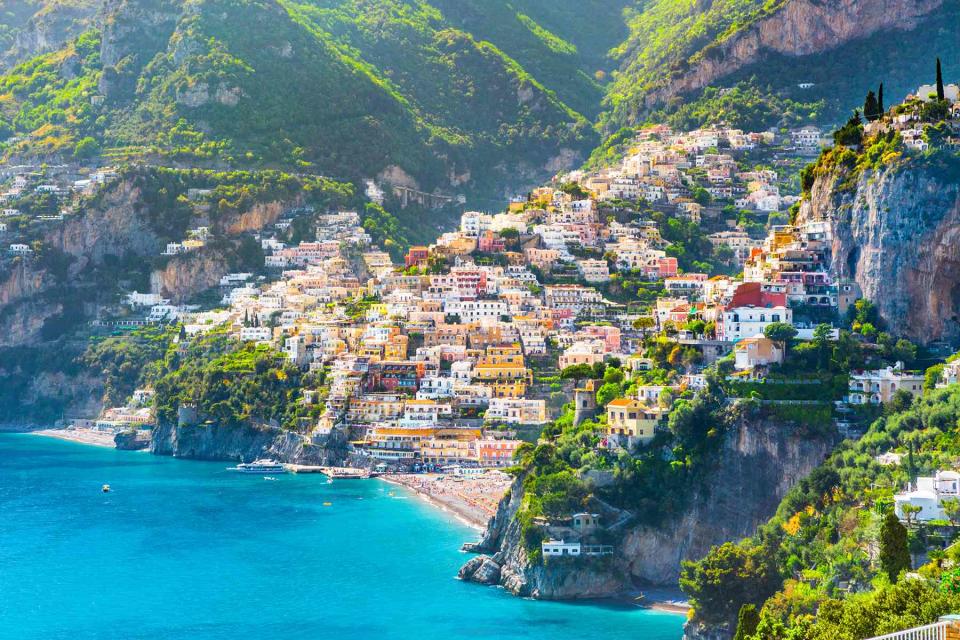
The allure of the Amalfi Coast has drawn people to the region that is now Italy for centuries. Its dramatic landscapes and idyllic weather enticed ancient Roman nobles to build their villas there long ago, and the high-end real estate trend never faded. Today, the mountains and cliffs remain dotted with breathtaking historic houses perched above the crystalline waters, making the coastline one of the most sought-after destinations in the world. Its fragile cultural landscape — churches, gardens, vineyards, and towns — is divided into 16 municipalities and is listed as a UNESCO World Heritage site. Positano, Ravello, and Amalfi are the area's top destinations, attracting hundreds of thousands of visitors each year. Here's how you can be one of them.
Getting to the Amalfi Coast
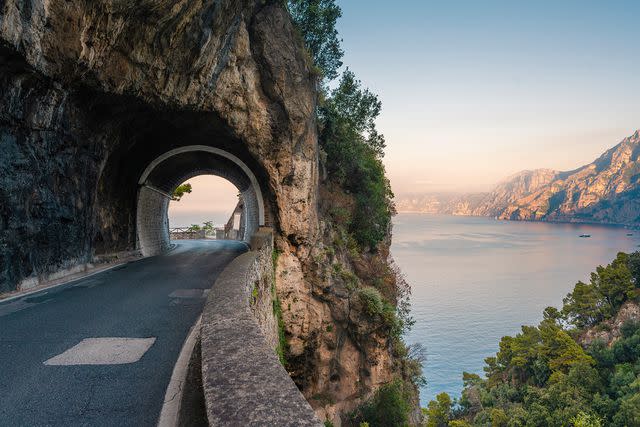
There are multiple ways to get to (and around) the Amalfi Coast. Whatever means of transportation you choose, be sure to book it well in advance of your trip.
By Train
The cities of Italy are connected by an expansive high-speed rail network. Make your way to Salerno from Rome (2.5 hours), Naples (one hour), or another region. From Salerno, there's a local train to Vietri sul Mare, the first town on the Amalfi Coast. The second leg takes only about 10 minutes.
By Boat
Ferries run along the coast between Amalfi and Salerno (30 minutes), Vietri sul Mare (45 minutes), and Sorrento (one hour). Travelmar travels between Salerno and Positano, stopping at all the main towns. From Sorrento, options include the Navigazione Libera del Golfo (NLG) and Alilauro Gruson. Alternatively, Alilauro runs a ferry service directly from Naples to Positano and Amalfi.
If you don't fancy ferries, you can also charter a boat. In most towns, travelers get their pick of companies offering private trips. If you want to book ahead, try Positano Boats or Lucibello.
By Car
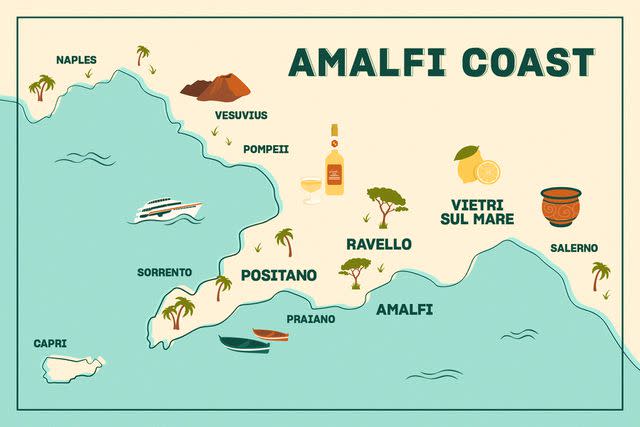
The Amalfi Coast is one of the world's most famous road trip routes, and driving along its switchbacks, high up on the cliffside, is truly spectacular. Both Salerno and Sorrento have all the major car rental companies, though local companies often offer better value. Salernorental is one known to be reliable.
Because traffic can be so excessive, the company that manages Italy's motorways rolled out an alternating license plate system for rental cars traveling the stretch between Positano and Vietri sul Mare. Since 2022, rental cars with odd-numbered plates have been banned from that section on odd-numbered days, and the same goes for cars with even-numbered plates on even-numbered days. The rule is enforced throughout much of the tourist season, between April and September, with some exceptions. Check the exact dates before you hit the road so you don't get fined for driving on the wrong day.
Another word of warning: If you're driving, be aware that the road is narrow in parts and full of sharp switchbacks, some of them requiring a bit of back-and-forth to get around. Note that traveling by road takes much longer than by sea — at least an hour from Positano to Amalfi, for example, compared to 25 minutes by ferry.
By Bus
Sita Sud buses run the length of the Amalfi Coast and provide some of the cheapest transportation. Those traveling from Rome or Naples can opt for one of the economic shuttle sharing systems, like Positano Shuttle. It'll scoop you up straight from the airport in Rome or Naples and deliver you to your accommodation in Positano.
Best Amalfi Coastal Towns to Visit
Positano
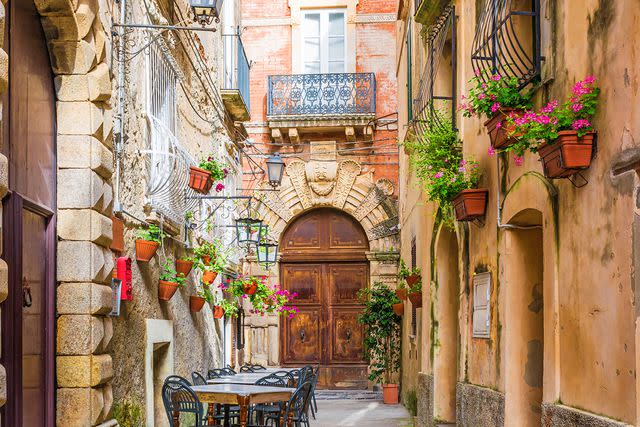
If you've seen the Amalfi Coast on Instagram, chances are you've seen Positano. With its brightly colored houses spilling over the cliffs around a bay, and dramatic mountains rearing up in the background, the village is picture-perfect.
Travelers will find shops selling locally made linen clothes and vintage, tailored styles. Positano is particularly known for handcrafted sandals — try Nanà, where the Ruocco family has been making them to measure for generations.
When in Italy, learn how to cook as the Italians do. Buca di Bacco is a hotel that offers cooking classes to visitors. During these classes, offered daily, trainees help chefs prepare regional appetizers and first and second courses.
For history enthusiasts: Mar, the Roman Archeological Museum, is a stunning Roman villa beneath the town's bell tower. The relic has undergone excavation for a decade and only opened to the public in 2018. Restoration work continues, but the colorful frescoes are primed for admiration and make Mar well worth a visit on their own.
Positano is also the endpoint for one of Italy's most stunning hiking trails. Hemmed into the mountains above the coast, the Path of the Gods is a gentle four-hour hike that snakes high above the sea. It starts outside the village of Bomerano and runs west of Amalfi, to Nocelle, then to Positano.
Where to Stay in Positano
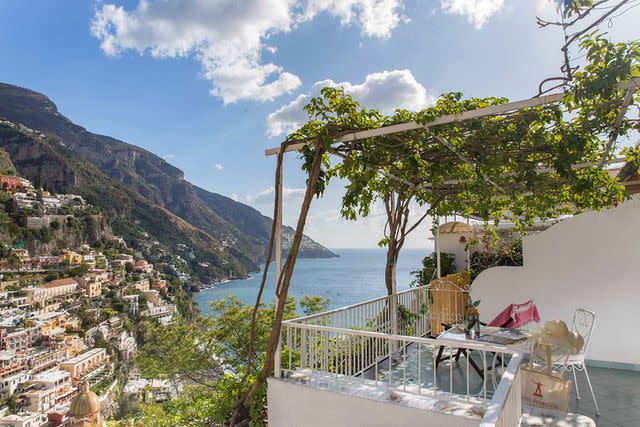
Book a room at the four-star Hotel Poseidon to immerse yourself in Positano's bohemian flair. Family-owned since it opened in the 1950s, this property is laidback and friendly. Vintage-style rooms are large, and all but one overlook the town and sea from private balconies. Perched above the center of Positano, it's removed enough to avoid the tourist crowds but still a quick walk down to the action.
If you prefer to stay right in the center of it all, the charming Hotel Palazzo Murat is located in the pedestrian zone by the waterfront. While it lacks the knockout views of higher-up hotels, its sizable private courtyard planted with palms and fragrant flowering vines is a lovely place for a candlelit aperitif.
Le Sirenuse is another Positano institution, terraced into the cliffs on the opposite side (and a bit lower down) from the Poseidon. It's a feast for the eyes, surrounded by exquisite tile work, lemon trees, and plentiful art.
Where to Eat and Drink in Positano

At Michelin-starred restaurant Zass in Positano, chef Alois Vanlangenaeker builds artful culinary creations, from fruits and vegetables grown on the property to local meats to seafood caught fresh each day. And while it may not have a Michelin star (the owners deliberately avoid making this a hot spot to keep the familial atmosphere), Il Tridente at Hotel Poseidon is also exceptional. You'll eat local dishes, like the sublime shrimp carpaccio, off crockery hand-painted in Vietri sul Mare.
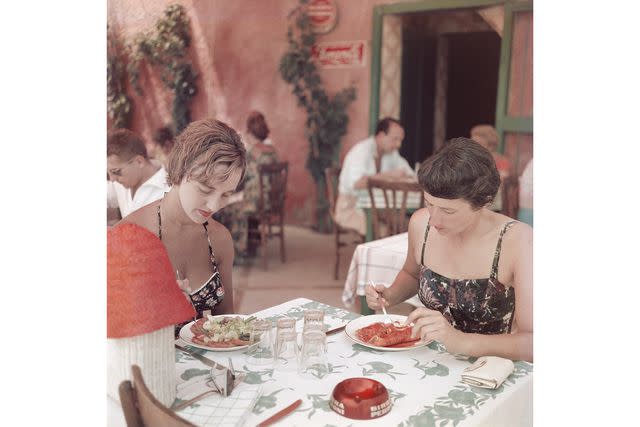
Another place to try is Da Vincenzo. Since 1958, the family-owned restaurant has served regional seafood and pasta dishes, like rigatoni alla genovese and cod cooked in oil and Amalfi lemon peel. Le Tre Sorelle, a more affordable dining option located on the beach, is consistently good and has served traditional Amalfitano dishes since 1953.
Amalfi
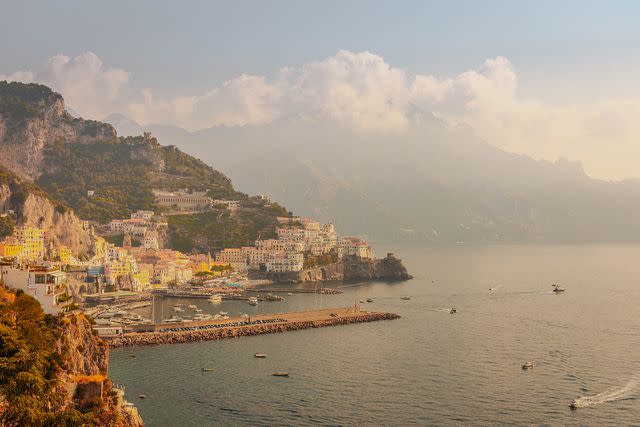
Amalfi is the largest town on its namesake coast. It serves as a major intersection for nearly all the buses, boats, and ferries shuttling tourists between the islands and towns, which means the crowds there can be overwhelming. Many would argue that the town's ninth-century Duomo di Amalfi makes the swarms of tourists worth braving, though. The church is treasured for its collision of various architectural styles and materials — it draws on Arab-Norman, Romanesque, Byzantine, and Rococo designs.
Amalfi used to vie with Venice and Genoa as one of the three maritime republics of the Italian Peninsula, and if you look past the shops selling lemon soaps, limoncello, and Amalfi tea towels, you'll see some fascinating remnants of history. The Museo della Carta — dedicated to Amalfi's handmade paper industry — is one of them. Take a tour of the still-operational 13th-century mill to see exactly how the paper is produced. For more antique oddities, La Scuderia del Duca sells art and stationery on the famous Amalfi paper, plus the odd antique.
Of course, Amalfi lemons are everywhere, but the best way to see them is through the Amalfi Lemon Experience. The Aceto family has been growing lemons less than a mile from the coast for six generations. The farm is open to the public for limited tours of the lemon groves, picnics, and cooking classes with the family. Not only is a visit lovely, but you'll get an idea of the backbreaking labor involved with growing lemons on mountain terraces and working the land by hand.
Where to Stay in Amalfi
The Anantara Convento di Amalfi Grand Hotel, a converted 13th-century monastery, sits high up on the cliffs like a white palace. It's an eight-minute walk from Amalfi and has two restaurants, a pool area, a gym, and a spa. Those who drive to Amalfi will appreciate the hotel's on-site valet parking.
A bit further west, Hotel Santa Caterina provides an excellent buffer from the hectic summer crowds. The property has a beach club with a pool and a sun deck with views of the town. The rooms and suites, most with small terraces and sea views, are few, which makes this place more intimate.
Borgo Santandrea, which opened in 2021 two miles west of town, is a fresh, modern take on Amalfi style. One of its major highlights is the elevator that rides down the cliff to a private beach complete with a restaurant.
What to Eat and Drink in Amalfi
Amalfi locals have been eating at Trattoria da Gemma since 1872. You could spend an entire afternoon grazing through its tasting menu, enjoying locally sourced dishes like tuna carpaccio and homemade pasta.
For a more casual dining experience, go for pizza or a plate of seafood in the homey dining room of Trattoria da Maria. The pies here are simple and traditional, topped with combinations like buffalo mozzarella and ham or sausage and broccoli.

Make sure to try some local pastries, too. Pasticceria Pansa has been an Amalfi institution since 1830. Try the delizia di limone: lemon cream in a sponge case, drizzled with lemon sauce.
Ravello
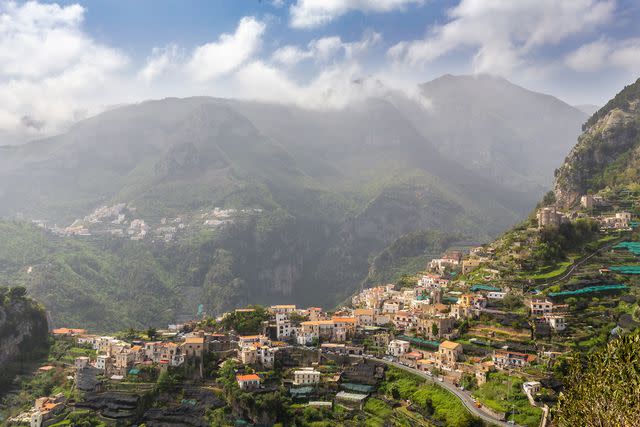
If you visit Ravello — the town high in the hills above Amalfi — and don't spend an hour or two roaming through Villa Cimbrone's gardens, you're essentially missing the point. From Ravello's central piazza, signs will lead you to the storied gardens, which are part of a palatial 11th-century compound perched on the coast. Some, such as the well-traveled late American writer Gore Vidal, have proclaimed the spot the most beautiful they've ever visited.
Within the historic center of Ravello is the Villa Rufolo, a stunning example of regional 13th-century architecture with beautiful Italianate gardens overlooking the blue water below. During the summer months, the villa and gardens host spectacular outdoor concerts.
Where to Stay in Ravello
Most accommodations in Ravello come with gorgeous views of valleys, mountains, oceans, and ancient towns. Still, there are a few five-star standouts. The Caruso, a Belmond Hotel, has 50 rooms and suites, with details such as vaulted ceilings and 18th-century frescoes, and beautiful grounds overlooking the coast.
There's also the jaw-dropping Hotel Villa Cimbrone, a 12th-century building perched on the sea cliffs and enclosed by stunning gardens.
The over-the-top rooms and suites at Palazzo Avino feature antique furniture and rugs, giving it a more classic, regal feel. The hotel's clubhouse is spectacular and built right into the cliffs, with a poolside restaurant and bar.
What to Eat and Drink in Ravello
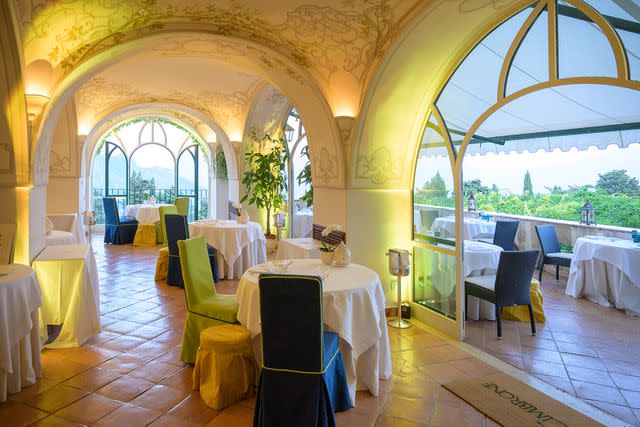
Tourists from all over the Amalfi Coast queue up for a table at Il Flauto di Pan in Hotel Villa Cimbrone. Chef Lorenzo Montoro is at the helm of this Michelin-starred establishment, drawing on the surrounding countryside to create his menu. It's costly, but the superb food and sea views from the garden terrace are worth the cost.
Piazza Vescovado, Ravello's square, is a beautiful place to refuel or relax in the shade of the cathedral. Visitors spill out onto the piazza for drinks, gelato, or granita at a handful of cute, simple bars ringing the square.
Vietri sul Mare
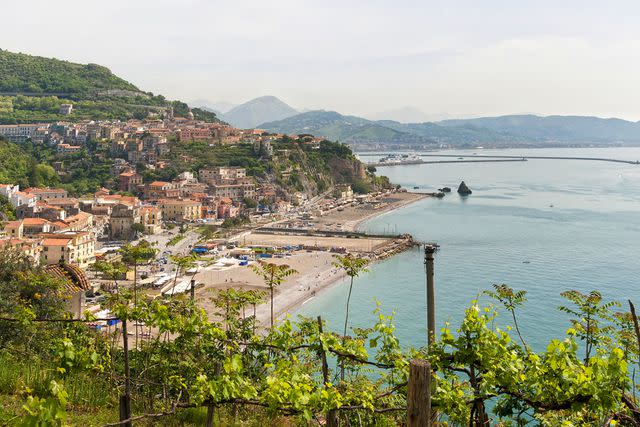
Those brightly colored, hand-painted plates and bowls sold all along the coast? They're likely from Vietri. There's even a museum dedicated to the tradition — the Museo della Ceramica — just outside town.
Walk around the streets, and you'll see tiles everywhere: donkey-shaped designs for every house number, portraits of saints painted over strips of tiles on walls, and tiles that have been adorned with the same patterns for centuries. Solimene is the primary producer, housed in a gigantic warehouse store above the town, clad in tiles like a Gaudi building in Barcelona.
Then, there's Mirkò: a superb modern artist who has taken the Vietri tradition to new heights. His artworks, which can cost thousands, are sold around the world, but he also makes smaller, much more affordable tiles for his shop in his hometown.
Where to Stay in Vietri sul Mare
Deluxe rooms and suites at the five-star Hotel Raito Amalfi Coast open up to terraces overlooking Vietri and the coastline. The decor is crisp, elegant, and, of course, includes locally made ceramics. Relax by the pool in the sun before cleaning up for an upscale dining experience on the terrace of on-site Il Golfo, where views abound.
What to Eat and Drink in Vietri sul Mare
Take in the essence of Vietri from at outdoor table at Ristorante Sud Est, a laidback pizzeria serving fluffy Neapolitan-style pizza, seafood, and pasta dishes. Or take a break from the typical pizza-and-pasta fare and try the Mediterranean tapas at Passariello Cantina Mediterranea, a casual wine bar also known for its cocktails.
When the time calls for a more polished environment, Il Principe e la Civetta is a great option. Menu standouts include ricotta and lemon ravioli with pumpkin and shrimp, spaghetti with pesto and anchovies, and the fresh catch of the day.
Best Time to Visit the Amalfi Coast for Good Weather
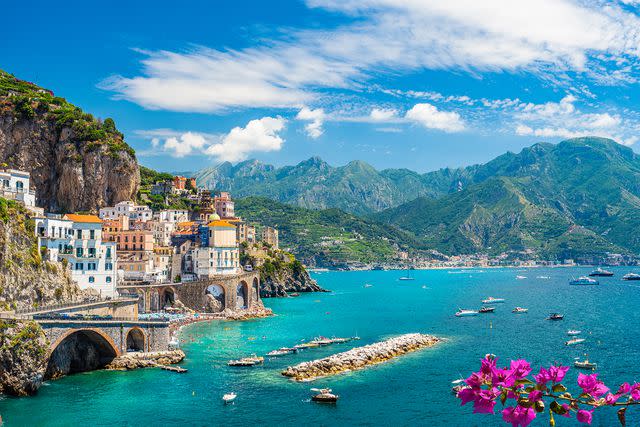
The weather on the Amalfi Coast is best in May, when it's warm yet fresh enough to walk the vertiginous towns. You can also see wildflowers blooming along the roadside during this time. September and June are also beautiful, as is October, when the sea is still warm enough for swimming. July and August tend to be very hot and humid, which is made even more uncomfortable by the throngs of tourists jamming into the towns.
Cheapest Time to Visit the Amalfi Coast
The Amalfi Coast isn't so much a destination for the winter months since most activities revolve around the water. Outside of the busy season, April to October, you might struggle to find accommodations, and many shops and restaurants are closed. So, instead of going for a winter bargain, try April, early May, or late September to October. Prices tend to rise from June until mid-September.
Best Time to Avoid the Crowds
Winter is the least busy time, but also perhaps the least appealing to those who want to experience the best of the Amalfi Coast. Instead, go midweek during the cheaper months — May, April, and September — and you'll find it quiet, particularly in the evenings when the day-trippers have gone home, but also still accommodating to tourists.
For more Travel & Leisure news, make sure to sign up for our newsletter!
Read the original article on Travel & Leisure.

